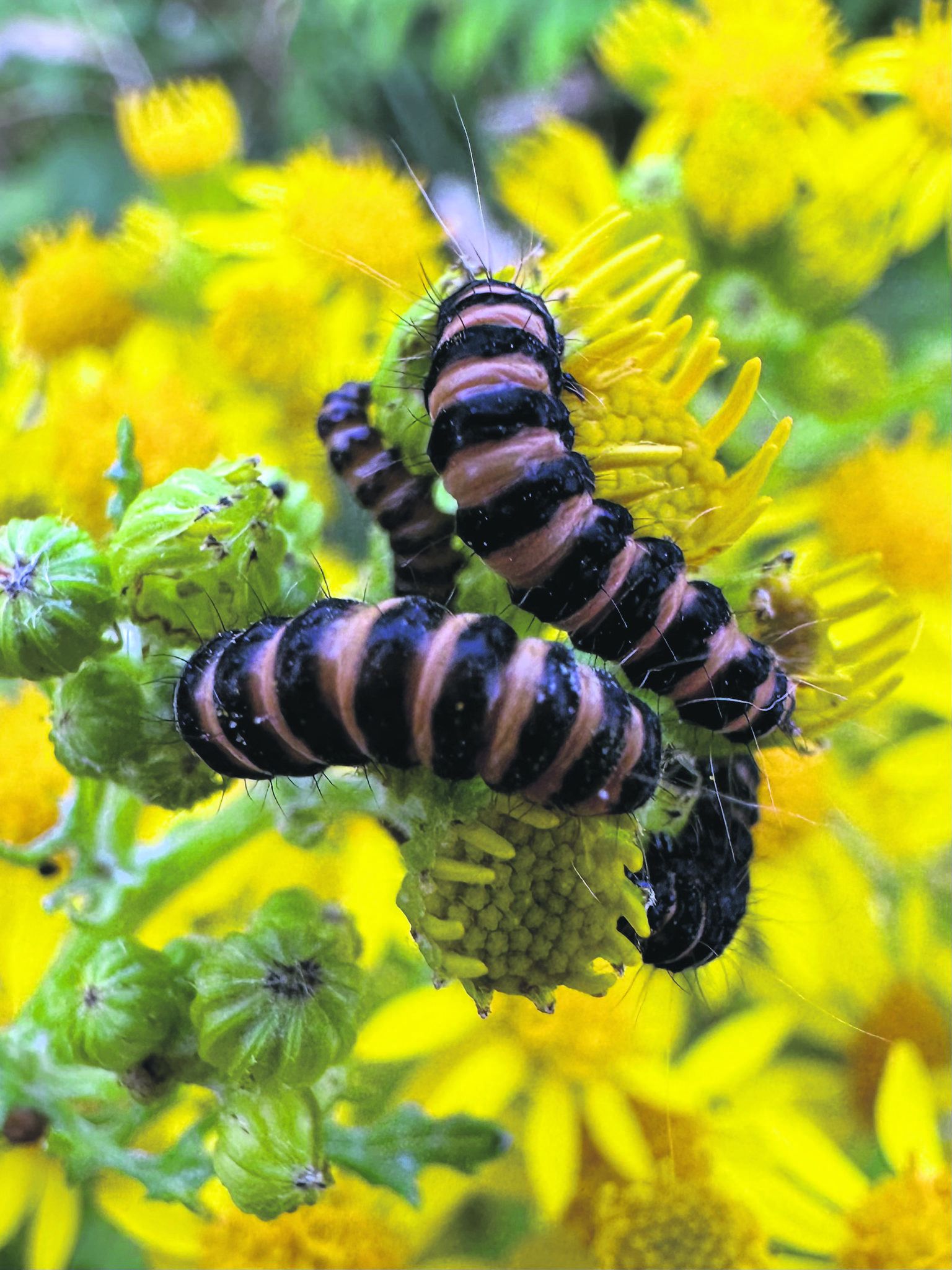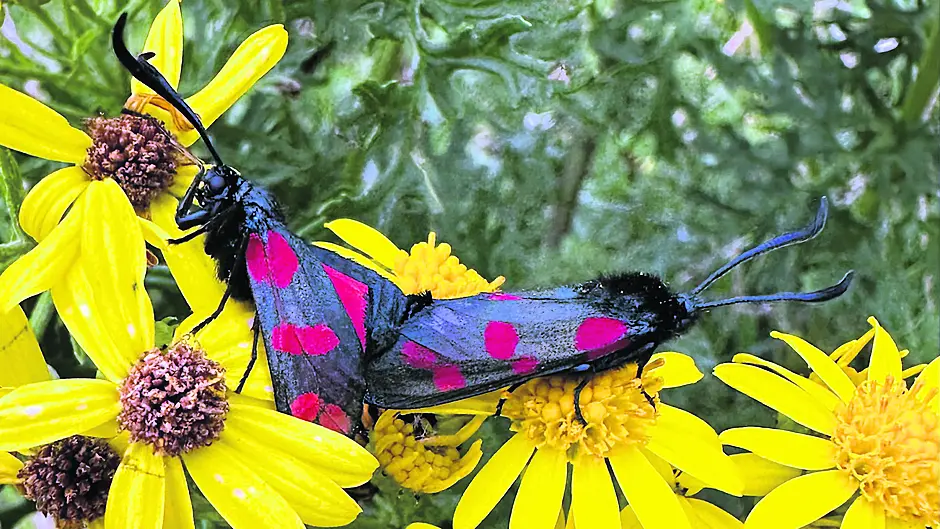BY ANN HAIGH
The seasons seem to come around far too quickly. It feels like just yesterday we were observing cinnabar moth (Tyria jacobaeae) caterpillars on ragwort along the country lanes, and now it is that time of year again. If you haven’t spotted any yet, keep an eye out. Cinnabar caterpillars are striking with their bright yellow-orange and jet-black alternating bands. They feed exclusively on ragwort and are usually found near the top of the plant, feeding on the flowers and leaves.
One thing that often confuses people is the appearance of a black and red moth that coincides with these caterpillars. Indeed, they are often found on the same plant. However, don’t be fooled—things are not always what they seem, and these are not the parent moth.
Clearing confusion
If you are watching cinnabar moth caterpillars feed on ragwort, you might often see six-spot burnet (Zygaena filipendulae) moths nearby. These pretty medium sized moths frequently emerge in large numbers, feeding on ragwort, knapweed, thistles and other grassland flowers. They are relatively easy to identify, with six red spots on each black forewing.
It is a common mistake to think that these moths are responsible for the vibrant caterpillars on the ragwort. However, the parent cinnabar moth is more elusive, dislikes flying during the day, and predominantly flies at night. The caterpillars of the six-spot burnet don’t feed on ragwort, preferring common and greater bird’s-foot trefoil instead. Even though the adult moths of both species are black and red and similar looking, their caterpillars are completely different and they are not related species
Six-spot burnets
Six-spot burnets are day flying moths, on the wing from June to August. Their caterpillars are also brightly coloured but are usually less conspicuous than cinnabar caterpillars, having yellow and black dots on a green or greenish-yellow body. The caterpillars need to spend at least one winter in hibernation before emerging and pupating in spring. You might have seen their papery pale yellow cocoons on grass or ribwort plantain stems, either still in development or vacated with the tell-tale black remains of their transformation from caterpillar to moth poking out the top.
 Cinnabar moth showing the distinctive red bar on the edge of their forewing. This moth is nocturnal, seen here attracted to a light, and is rarely seen during the day.
Cinnabar moth showing the distinctive red bar on the edge of their forewing. This moth is nocturnal, seen here attracted to a light, and is rarely seen during the day.
Cinnabar moths
The cinnabar moth, with its black and perfect shade of red, was originally named after the bright red mercury ore, cinnabar, once used by artists as a red pigment for painting and jewellery. Like the six-spot burnet, this moth’s hindwings are red, but they have both spots (two) and a bold red bar on each forewing’s upper surface. Cinnabar moths are similar in size to six-spot burnets, being approximately two cm long with a wingspan of four cm. Interestingly, the cinnabar mineral, from which they get their name, is now rarely used because it is toxic; and so too are cinnabar moths.
Controversial ragwort
The ragwort (Senecio jacobaea), or as Gaeilge, Buachalán buí, that hosts the cinnabar caterpillars, is a well-known native plant with bright yellow flowers. Most notably, it is recognised by farmers and people that graze animals as a toxic plant. While it is beneficial to large array of insect life, not just cinnabar moths, due to concerns for livestock and pasture productivity, it is legally classed as a noxious weed under the 1936 Noxious Weed Act. This means that the Department of Agriculture, Food and the Marine have the power to enforce ‘Notices to Destroy’ where they are aware of ragwort growing in excess on private land.
Grazing animals will naturally avoid ragwort; however, should hungry animals need to eat ragwort through lack of pasture or if it gets into hay or silage, toxic alkaloids in the plant can lead to liver failure and death. Cinnabar caterpillars, however, use this to their advantage.
 Cinnabar moth caterpillars on ragwort.
Cinnabar moth caterpillars on ragwort.
Toxic caterpillars
Each female cinnabar moth can lay up to 300 eggs in 5-10 batches on the underside of ragwort leaves. They may be seen feeding quite brazenly out in the open, exposed to birds and other predators. This is because those bright yellow and black stripes serve as a warning to deter predators. As the caterpillars feed on ragwort, they accumulate the plant’s toxins. These toxins will even persist in the adult moth after metamorphosis. Any predators that ignore the warning colouration will be repulsed by a foul taste should they try to ingest them.
Common ground
While this article strives to help you distinguish between these two common moths—the six-spot burnet and the cinnabar moth—and their respective caterpillars, they do share a peculiar commonality. They are both aposematic moths; a new word for me, but a good one. It means that they both have colours or markings to repel predators. The red spots of the six-spot burnet moths are also a sign of toxicity.
While cinnabar caterpillars simply accumulate the toxins from what they are eating, six-spot burnet caterpillars go one step further. The caterpillars do accumulate toxins from the bird’s-foot trefoil, their food plant, but they are also able to produce hydrogen cyanide—a chemical compound that gives them a bad taste and, in large quantities, can kill a predator. Like the cinnabars, all life stages are toxic. The moth can release cyanide if attacked, and females will also emit it to attract males. It would be the ultimate definition of a femme fatale if the males were susceptible to the poison themselves.
 Six-spot burnet moth caterpillar getting ready to pupate. These caterpillars are foul-tasting and toxic to birds and other predators.
Six-spot burnet moth caterpillar getting ready to pupate. These caterpillars are foul-tasting and toxic to birds and other predators.
Final thoughts
In the natural world, even the most beautiful creatures can harbour hidden dangers. However, while these two moth species may be toxic to their predators, they are harmless to humans. It is just another fascinating example of how wildlife has developed in synchrony with the environment to optimise survival. By understanding and appreciating the unique adaptations of the cinnabar and six-spot burnet moths, we can gain a deeper respect for the delicate balance of our local ecosystems. When you’re next out for a walk, keep an eye out for six-spot burnet moths and cinnabar caterpillars, but as one source wrote, don’t eat them as they won’t taste very nice!










